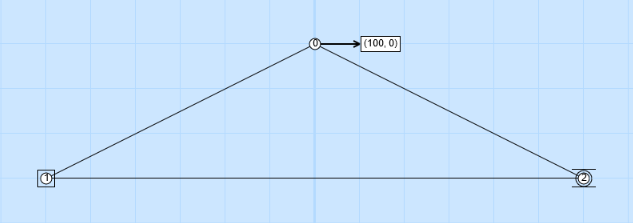In Straws We Trussed - Page 5
HORIZONTAL LOADING
Let us consider yet another scenario. In this case, the gorilla is hanging for dear life from the truss in the middle of a hurricane. The hurricane winds are blowing so hard that the gorilla exerts exactly 100 pounds of force on the top truss node in a horizontal direction to the right.
Remove any previous loads and add a 100 unit load to the right. Keep it perfectly horizontal by lining it up with the grid.

Recalculate the forces that result from the horizontal load.

First notice the reactions on the supports. Although it is hard to see, the fixed node has a reaction of 100 units to the left - in the opposite direction of the load. Notice however that these two forces are not lined up with one another - one pulls to the right at the top of the truss and one pulls left at the bottom of the truss. Together these two forces would tend to cause the truss to spin in a clockwise direction. Forces like this that go in opposite directions and are not lined up so that they exert a spinning influence are known together as a couple.
Notice that there are two other reactions, a vertical reaction down on the fixed node and a vertical reaction up on the horizontal rolling node. These reactions are also 'equal and opposite' (within the 1 unit error), and together form another couple. This couple, however, works in a counter-clockwise direction, and thus balances the first one!
We also notice that the left side of the bridge is 'pulled' by the load and is therefore in tension, while the right side is being 'pushed' so it is in compression. The bottom member experiences tension. Why is that? Well, since the right side member is in compression, it is being pushed and is also pushing back (remember 'equal and opposite reaction'?), so it is pushing on the bottom right node, down and to the right. The support on the this node does some of the pushing back, by pushing up. However, there needs to be something preventing the node from moving to the right, and in this case, the bottom member pulls (and is pulled) in order to balance the forces on the 'rolling' support node.
Would it be the same if the load pointed in the other direction? Let's try it. Remove the load and add a new 100 unit load going to the left side of the structure, rather than the right. Now, calculate. What do you find? As you might expect the left and right members switch roles from tension to compression and vice versa. The bottom member also switches, from tension to compression and the reactions also switch! Once again, reversing the direction of the loads also reverses the response of all parts of the truss.
Do these results make sense? Why does the bottom member stretch when the forces is to the right and squish when the forces is to the left? The answer actually has to do with where we placed the 'fixed node'. Because the fixed node is on the left, the horizontal reaction force occurs on the left, and 'pushes' or 'pulls' from that side. If we switched the supports and put the fixed node on the right and the rolling node on the left, that would also switch how the bottom member would behave (try it!)
| On to Page 6! |